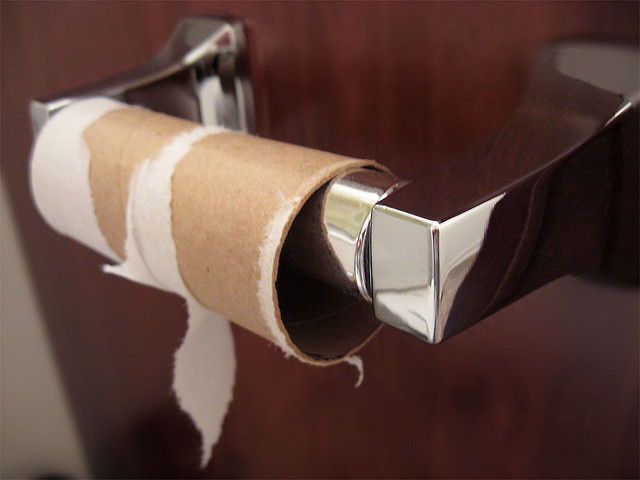4 Ways to Reduce and Recycle in the Bathroom
 Recycling has come a long way since the very first Earth Day in April 1970. Collecting used paper, cans, and containers to be reprocessed into usable goods has become a healthy habit for thousands of Americans of all ages. However, in many homes, recycling efforts are confined to the kitchen. That's a great start, but if you'd like to explore new frontiers in green living, try recycling and reducing in your bathroom as well. The best place to begin? Set up a neat place for you and your family to stash recyclables in your bath's small space. Here are instructions to reduce or recycle common materials that would otherwise end up in your bathroom trash.
Recycling has come a long way since the very first Earth Day in April 1970. Collecting used paper, cans, and containers to be reprocessed into usable goods has become a healthy habit for thousands of Americans of all ages. However, in many homes, recycling efforts are confined to the kitchen. That's a great start, but if you'd like to explore new frontiers in green living, try recycling and reducing in your bathroom as well. The best place to begin? Set up a neat place for you and your family to stash recyclables in your bath's small space. Here are instructions to reduce or recycle common materials that would otherwise end up in your bathroom trash.
Paper
There are two ways of dealing with the plethora of paper in your bathroom. Clean, dry items like toilet paper rolls and tissue boxes are simple to recycle. However, wet paper should not be tossed into the nearest appropriate recycling receptacle. Its moisture is likely to cause mold growth, which can make the whole batch unsuitable for recycling. An alternative method for eco-friendly disposal of used uncontaminated items such as facial tissues and paper towels is to add them to your compost, treating them as brown material. If you don't have a backyard compost heap, you can include paper towels with your yard waste, with your waste disposal company's approval.
Plastic
Bottles, bottles, bottles. While we can understand the logic behind packaging personal hygiene products such as mouthwash or liquid soap in plastic (which, if dropped by slippery hands, won't shatter as glass bottles would), it does tend to pile up. Try to buy bathroom bottles and jars according to plastic type. Clear PET plastic is the kind most readily accepted by recycling centers, followed by HDPE. Plastics with recycling codes 3, 6, and 7 are not only less easy to recycle; they are also hazardous to human health. Try to avoid buying bathroom products in these types of plastics.
A useful green principle to put to work here is Reduce. You'll have less to recycle if you buy lotions and scrubs in bulk, to be transferred into smaller-sized, easier-to-handle containers -- repurposed, of course. Use a dedicated funnel for the task. Reduce even more by making your own cleansers and creams from natural ingredients. Don't have the time or inclination to hassle with pouring and mixing? You can still reduce your use of shampoos and body washes by lathering up only once. And while you're at it ... you know how this kind of product comes with a little headroom at the top? Fill that inch or two with water, cap the bottle, and shake.
Water
If you love to garden, there's a big green change just waiting to happen in your bathroom. Installing a graywater system will save precious water by recycling "gently used" runoff from such purposes as brushing your teeth or taking a bath. Please note, though, that you must use biodegradable toothpastes, soaps, and so on that are compatible with graywater systems. What is more, while this recycled water may be utilized to rinse your patio or water your lawn, it should not be sprinkled directly onto food crops. Check local regulations before having a graywater system added to your plumbing. Simpler water recycling actions include placing a bucket in your shower to catch the initial flow, before the water runs warm. Then use the clean water you've collected to fill pets' dishes or water houseplants. Or pour it (fast and hard) into your toilet for a "free" flush.
Laura Firszt writes for networx.com.
Looking for a Pro? Call us (866) 441-6648

Plumbing Average Costs
Plumbers Experiences

Tree Removal For The Last Part Of A Poor Old Mulberry

Lawn Repair: Contractor Followup To My DIY Prep Got The Job Done



